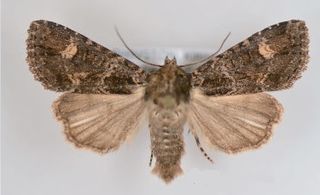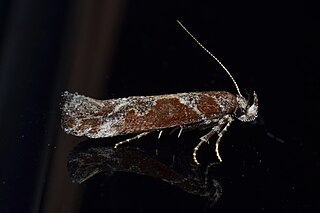
The cinnabar moth is a brightly coloured arctiid moth found as a native species in Europe and western and central Asia then east across the Palearctic to Siberia to China. It has been introduced into New Zealand, Australia and North America to control ragwort, on which its larvae feed. The moth is named after the red mineral cinnabar because of the red patches on its predominantly black wings. The species was first described by Carl Linnaeus in his 1758 10th edition of Systema Naturae. Cinnabar moths are about 20 mm (0.79 in) long and have a wingspan of 32–42 mm (1.3–1.7 in).

Eacles imperialis, the imperial moth, is a Nearctic member of the family Saturniidae and subfamily Ceratocampinae. The species was first described by Dru Drury in 1773.

Grammodes stolida, the geometrician, is a moth of the family Erebidae. The species was first described by Johan Christian Fabricius in 1775. It is found in Africa, southern Europe, most of Asia and Australia. It migrates to central and northern Europe as far north as England, Denmark and Finland.

Aseptis binotata, the rusty shoulder knot moth, is a moth of the family Noctuidae. The species was first described by Francis Walker in 1865. It is found widespread in western North America, west of south-central Alberta, Wyoming, and Nebraska. Along the Pacific Coast it occurs from northern Mexico to south-central British Columbia. It can be found from sea level to altitudes over 2000 meters in a variety of habitats from dense forest to shrub desert.

Xylophanes libya, the Libya sphinx, is a moth of the family Sphingidae. The species was first described by Herbert Druce in 1878. It is known from southern Texas, Mexico, Belize, Guatemala, Panama and from Venezuela south and west to Bolivia and Paraguay.

Ischyja manlia is a species of moth of the family Noctuidae first described by Pieter Cramer in 1776. It is found in the Indian subregion, Sri Lanka, Myanmar, Thailand, China, Okinawa, Sundaland, Sulawesi, Korea, the southern Moluccas, Australia (Queensland) and Palau. Adults pierce the skin of fruit to suck the juice.

Synanthedon formicaeformis, the red-tipped clearwing, is a moth of the family Sesiidae and can be found in all of Europe, the eastern Palearctic realm, and the Near East. The larvae sometimes form pear-shaped galls on willows. It was first described by Eugenius Johann Christoph Esper in 1783.
Adela ridingsella, Ridings' fairy moth, is a moth of the Adelidae family or fairy longhorn moths. It was described by James Brackenridge Clemens in 1864. It is widespread in eastern North America, from Nova Scotia, Ontario, Quebec and Maine to Pennsylvania and the mountains of North Carolina.

Cnephasia longana, the omnivorous leaftier moth, long-winged shade or strawberry fruitworm, is a moth of the family Tortricidae. It was described by Adrian Hardy Haworth in 1811. It is native to western Europe. It is an introduced species in western North America. The species has also been reported from north-western Africa and Asia. The habitat consists of downland and rough ground.

Gnorimoschema baccharisella is a moth in the family Gelechiidae. It was described by August Busck in 1903. It is found in North America, where it has been recorded from California.
Gnorimoschema batanella is a moth in the family Gelechiidae. It was described by August Busck in 1903. It is found in North America, where it has been recorded from California, Illinois, Kentucky, Maine, New Jersey and Ontario.
Gnorimoschema semicyclionella is a moth in the family Gelechiidae. It was described by August Busck in 1903. It is found in North America, where it has been recorded from Colorado, Oregon, Wyoming and New Mexico.
Gnorimoschema coquillettella is a moth in the family Gelechiidae. It was described by August Busck in 1902. It is found in North America, where it has been recorded from California and Colorado.
Gnorimoschema gibsoniella is a moth in the family Gelechiidae. It was described by August Busck in 1915. It is found in North America, where it has been recorded from Alberta, Manitoba and Illinois.
Gnorimoschema salinaris is a moth in the family Gelechiidae. It was described by August Busck in 1911. It is found in North America, where it has been recorded from Florida, Illinois, Kentucky, Maine, Massachusetts, Michigan and New York.
Gnorimoschema subterranea is a moth in the family Gelechiidae. It was described by August Busck in 1911. It is found in North America, where it has been recorded from Massachusetts, Colorado, California, Alberta, British Columbia and Ontario.
Gnorimoschema octomaculella is a moth in the family Gelechiidae. It was described by Vactor Tousey Chambers in 1875. It is found in North America, where it has been recorded from California and Washington.
Gnorimoschema busckiella is a moth in the family Gelechiidae. It was described by William D. Kearfott in 1903. It has been recorded from the US states of Maine, New Jersey and Ohio.

Gnorimoschema gallaesolidaginis, the solidago gall moth, goldenrod gall moth or goldenrod gallmaker, is a moth in the family Gelechiidae. It was described by Riley in 1869. It is found in North America, where it has been recorded from Alberta, British Columbia, California, Florida, Illinois, Indiana, Kentucky, Maine, Maryland, Massachusetts, Michigan, Minnesota, Mississippi, Missouri, New Brunswick, New Hampshire, New York, North Carolina, Ohio, Oklahoma, Ontario, Pennsylvania, Quebec, Tennessee, Texas and Wisconsin.
Gnorimoschema shepherdiae is a moth in the family Gelechiidae. It was described by Ronald J. Priest in 2014. It is found in North America, where it has been recorded from Alberta, British Columbia, Manitoba, Michigan, Quebec and Yukon.









